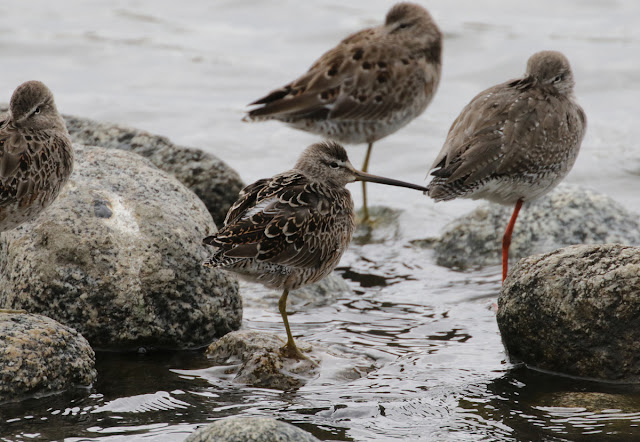Just as its rusty juvenile plumage set it apart from the two adults in early winter, its slightly earlier moult into alternate plumage this spring rendered it equally eye-catching compared to its duller
companions.
 Compared to the bird behind it the mantle and scapular moult is more advanced, hence blacker. Most old tertials have or are being replaced whereas the other two birds are still largely in basic gray.
Compared to the bird behind it the mantle and scapular moult is more advanced, hence blacker. Most old tertials have or are being replaced whereas the other two birds are still largely in basic gray.Apart from being noticeably small and short-billed, which was so obvious last time, better views this time show that it's relatively long-winged. In early winter I mentioned the noticeable primary projection but was unsure whether this was due to growing teritals - thinking about it that seems unlikely given age and time of year. Growing tertials were a consideration this time but it was possible to see that the primary tips fall beyond the tail, unlike most Long-billed which usually have primaries equal to or falling short of the tail. So perhaps this bird is both at the shorter end of the bill length range and at the longer end of the wing length range.
 As close to a head profile as I could get; the bill is clearly at the shorter end of the Long-billed range but not a record breaker, the shape could change a little but it's generally straight lacking any downward kink that might be hoped for in a Short-billed, it isn't particularly deep-based and the loral angle is shallow. The body is marginally less square-on here but nevertheless the slight primary extension beyond the tail can still be seen. That the tarsus (and tibia) frequently looks distinctly short is no doubt simply because this is a much smaller bird overall.
As close to a head profile as I could get; the bill is clearly at the shorter end of the Long-billed range but not a record breaker, the shape could change a little but it's generally straight lacking any downward kink that might be hoped for in a Short-billed, it isn't particularly deep-based and the loral angle is shallow. The body is marginally less square-on here but nevertheless the slight primary extension beyond the tail can still be seen. That the tarsus (and tibia) frequently looks distinctly short is no doubt simply because this is a much smaller bird overall. Long-billed at a comparable angle showing its significantly longer bill and primaries not reaching the tail tip.
Long-billed at a comparable angle showing its significantly longer bill and primaries not reaching the tail tip.Another interesting feature to me is that the outermost rectrices are essentially black with a central white zig-zag line centrally from the base breaking into spots closer to the tip, rather than narrow white bars on black. Thus darker even than the expected pattern of Long-billed, while Short-billed show far more white. I don't know whether this pattern is unusual or merely not well documented in the literature.
 The outermost rectrices are usually hidden but here it's possible to see they are largely black with a central zig-zag white line and a couple of spots in the distal third.
The outermost rectrices are usually hidden but here it's possible to see they are largely black with a central zig-zag white line and a couple of spots in the distal third.Another identification feature to look out for seems to be barred or unbarred marginal coverts on the inner arm; barred for Short-billed and unbarred for Long-billed. My mini survey of just three birds supports this but here in Japan I may have to wait an awfully long time to check a Short-billed!
 A less helpful shot of the shorter-billed bird but those inner marginals are clearly unmarked. The unbarred outer tail feathers are safely tucked away and hidden, as is normally the case.
A less helpful shot of the shorter-billed bird but those inner marginals are clearly unmarked. The unbarred outer tail feathers are safely tucked away and hidden, as is normally the case. 










No comments:
Post a Comment